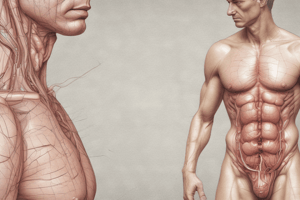Podcast
Questions and Answers
What is the most common imaging method used in the diagnosis of orchitis and epididymitis?
What is the most common imaging method used in the diagnosis of orchitis and epididymitis?
Ultrasonography
What information does ultrasonography provide in the diagnosis of orchitis and epididymitis?
What information does ultrasonography provide in the diagnosis of orchitis and epididymitis?
Testicular volume, presence of parenchymatous lesions, extent of fluid collections
What ultrasound findings are typically seen in uncomplicated epididymitis?
What ultrasound findings are typically seen in uncomplicated epididymitis?
Thickening of the tunica albuginea and increased internal acoustic reflection from the involved epididymis
When might further imaging with CT or MRI be needed in epididymitis?
When might further imaging with CT or MRI be needed in epididymitis?
What ultrasound findings may be observed in orchitis?
What ultrasound findings may be observed in orchitis?
How does imaging contribute to the detection and classification of scrotal infections?
How does imaging contribute to the detection and classification of scrotal infections?
When is a CT scan rarely indicated for scrotal infections?
When is a CT scan rarely indicated for scrotal infections?
In what scenarios could CT scan be considered for scrotal infections?
In what scenarios could CT scan be considered for scrotal infections?
What is the role of MRI in evaluating testicular masses?
What is the role of MRI in evaluating testicular masses?
How does MRI help in distinguishing between epididymitis and paratesticular abscesses?
How does MRI help in distinguishing between epididymitis and paratesticular abscesses?
What is the importance of clinical examination and laboratory tests in assessing scrotal infections?
What is the importance of clinical examination and laboratory tests in assessing scrotal infections?
How do imaging techniques aid in managing scrotal infections?
How do imaging techniques aid in managing scrotal infections?
Study Notes
Scrotal Infection: Imaging
Scrotal infections, also known as epididymitis or orchitis, can cause various complications if left untreated. As we delve into understanding scrotal infections, let's explore imaging techniques used to diagnose these conditions.
Imaging plays an essential role in the diagnosis of scrotal infections due to their heterogeneous nature, which includes inflammation, abscess formation, and localized pain. This section will focus on the types of imaging methods and how they contribute to the detection and classification of scrotal infections.
Ultrasonography
Ultrasonography is the most common imaging method employed in the diagnosis of orchitis and epididymitis. It provides valuable information such as testicular volume, the presence of parenchymatous lesions, and the extent of fluid collections present in the scrotum.
Epididymitis
For uncomplicated epididymitis, ultrasound findings typically reveal thickening of the tunica albuginea and increased internal acoustic reflection from the involved epididymis. However, if there are complex cystic changes within the epididymis, it may suggest rupture of the epididymis, warranting further evaluation with computed tomography (CT) or magnetic resonance imaging (MRI).
Orchitis
In the case of orchitis, ultrasound findings may show decreased testicular size, edema, and reduced blood flow in the affected area. Be cautious when interpreting the results, as some normal findings like spermatocele or varicocele may mimic the appearance of ipsilateral orchitis or epididymitis.
Computed Tomography
Computed tomography (CT) scan is rarely indicated for scrotal infections because of its limited diagnostic accuracy compared to ultrasound. However, it could be considered in three scenarios:
- When suspicion is high, despite negative results on ultrasound.
- To evaluate the extent of necrosis or abscesses, especially after surgical intervention.
- For suspected neoplasm cases where histopathology might be needed. CT is useful in revealing periprothetic infection after prosthesis placement, but this is rare in practice.
Magnetic Resonance Imaging
Magnetic resonance imaging (MRI) has become increasingly important in the diagnoses mentioned above. MRI serves as an excellent option for evaluating testicular masses, epididymo-orchitis, and other congenital anomalies.
Testicular Masses
Tissue characterization using MRI is crucial for determining whether a mass is benign or malignant. Histological subtypes of tumors can also be identified based on different MRI features, including T1 and T2 signal intensities, diffusion restriction, and enhancement patterns.
Epididymitis
In epididymitis, MRI shows intense enhancement of the epididymis, as well as asymptomatic epididymal involvement. MRI contrast uptake may help distinguish between epididymitis and paratesticular abscesses. Additionally, MRI can be helpful in monitoring treatment response.
Remember, while imaging techniques play a vital role in assessing scrotal infections, they should always complement clinical examination and laboratory tests. These tools aid in identifying the underlying disease processes, guiding treatment plans, and preventing potential complications.
Studying That Suits You
Use AI to generate personalized quizzes and flashcards to suit your learning preferences.
Description
Explore the imaging techniques used in diagnosing scrotal infections such as epididymitis and orchitis. Learn about the role of ultrasonography, computed tomography (CT), and magnetic resonance imaging (MRI) in detecting and classifying scrotal infections.


